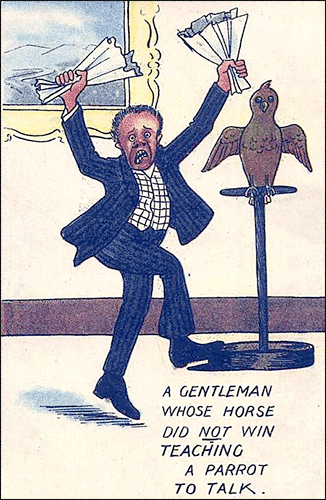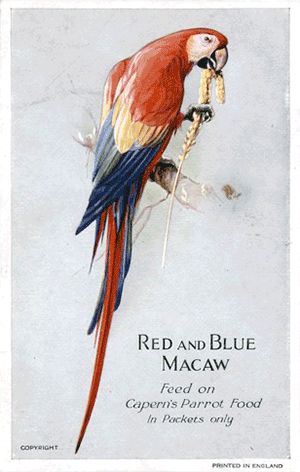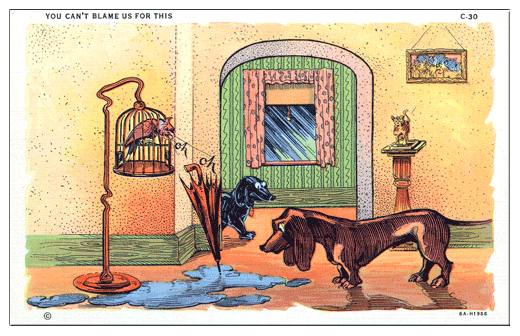It is possible to form a large collection of postcards around the theme of parrots and parakeets which were very popular subjects, especially on the early comic or saucy postcards. At the peak of their popularity, in the 1930s, sales of saucy postcards alone reached a massive 16 million a year.
To search eBay UK for parrot postcards, click here, and for eBay USA, click here.
The Bird Fancier
Here is another from the vast selection of British "seaside humour" postcards dating back to the cheeky 1950s. It's the kind of scene you might expect to see acted out by Sid James and Barbara Windsor in a Carry On film! The postcard was offered for sale on eBay, starting at £7.00.

"What do you say?"
This postcard, published by Bamforth and posted in 1956, was offered for sale on eBay at £4.99. I can't help feeling sorry for the parrot, he's obviously trying his best!

Votes for Women
This rather unusual postcard was in great demand on eBay when it was sold in April 2013 . . . so much so that the bidding ended at £75.00. By today's standards it is a rather crude design, but this example was posted in 1908 in the UK from Cirencester to Willesden, NW. It was not until 1918 that women over the age of 30, who met minimum property qualifications, were allowed a vote in the United Kingdom. Female descendants of the Bounty mutineers on Pitcairn Island were amongst the first women in the world who could vote when they elected members of their ruling councils from 1838.

Marvellous flow of language!
Here is another amusing postcard drawn by the artist Donald McGill. "Grey parrot for sale. The property of a soldier. Good tempered & amusing with a marvellous flow of language. Apply U.B. Blode, Sgt. Major."

Merry Christmas from Santa Claus & me
Published by The Gibson Art Company, this card was posted on 24th December 1919 and mailed to San Francisco. How many people today would risk sending their Christmas greetings the day before Christmas . . . even if they could?

Ristorante Pappagallo
This postcard, advertising the Parrot Restaurant in Bologna, Italy, was sold for $7 on eBay in 2011. The Pappagallo website gives a brief history of the restaurant, which opened in 1919 in a fourteenth century palace in Bologna, offering customers "rich and tasty typical Bolognese dishes" - sounds good!

The fortunate Iris Flint?
Toothless boy: "You can't believe how pleased I would be if you would be my valentine."
Parrot: "What a chance"
Sent to a Miss Iris Flint or Randolf, Vermont, date not known.

A quick comparison - '30s to '60s!
These two postcards came up for sale in October 2011. You can't get a much quicker way of comparing two decades than these two!


Very early 20th Century US cards
These four very early comic postcards recently came up for sale. They all feature a tiny parrot and an even smaller comment (which may have been funnier at the time!). The cards are American and these examples were posted during 1907 to 1909. Because the text is so small, I am listing the parrot's comments here, from top to bottom: (1) I wonder if that has a bottom to it; (2) What a perverted taste Fido has; (3) I look like a new Easter bonnet; (4) I'll bet they start him in the stone business.

Wig snatching
Here's a new trick to teach your parrot . . . wig snatching! This vintage comic postcard was sold in June 2011 for the bargain price of just 99p plus postage.

Curtain Lectures
The following three postcards were offered for sale on eBay in March 2011 with a starting price of $12.95*. The vendor stated that although one had been postally used, he couldn't read the date. They were published by the UK publishing company Raphael Tuck & Sons which was founded by a Prussian immigrant to the UK in 1865. (Find out more.)
Unfortunately it is not possible to enhance the captions on the cards, but the heading for the series is "Mrs Caudle's Curtain Lectures". This title is taken from a book of the same name published in 1846. In that story, by Douglas William Jerrold, a friend of Charles Dickens, the "lectures" were given to Job Caudle by his wife who found she could only talk to him without interruption in bed. (Find out more.)
*UPDATE: The auction item closed at $32.76 (eBay link)

Problems with talking parrots
Here we present two comic postcards, one old and one new, from two different centuries, but still the same joke about problems with parrots talking.


Birds of a feather
Who says that newspaper is for the bottom of the bird cage? The title of this card is "Birds of a feather, Flock together".

Foreigners picking up our language
Here is a card by the popular artist Donald McGill, we featured another of his cards previously, under the heading "Early British Cards". Sold recently on eBay, this reminded me of one of the videos, entitled "Grey Cat", featured on this website's video page!

Adverts on postcards
Many people collect adverts on postcards as a theme. We can be even more precise and collect adverts that have featured parrots on postcards! A quick search on eBay today (6th September 2010) found these five rather nice postcards used to advertise products like pears and biscuits, as well as a very nice card for the "Island Cafe". Most of the cards here are modern printings, but they do make an attractive addition to your collection.





Capern's Bird Foods
It would appear that there were at least three sets of postcards published around 1910 by Capern's to promote their packets of parrot food.
These cards can often be found for sale on eBay in varying condition. Some have plain backs and some are printed with a divided postcard back.
Can anyone remember Capern's food?





Curt Teich Invitation Postcard

This colourful postcard is from the Curt Teich company of Chicago, USA, published in 1938. Put out the cat, pull the blinds, lock up the doors and come to . . . while the parrot asks "where we going?".
There is a code on Curt Teich postcards which can be translated to give the date of printing. Inside the box where we are asked to place a one cent stamp (the good old days!), there is a tiny code "8A-H2134". The letter "A" indicates the 1930s and the "8" shows that it was 1938. A more detailed explanation can be found here.



Why did sailors (and pirates) have parrots?
There is an interesting article here which discusses whether pirates really did have parrots as pets.
That rather annoying parrot chanting "Pieces of Eight, Pieces of Eight" comes to mind when I think about Treasure Island for example.
According to this website, Macaws were used by sailors in the old days for sailors who could not speak. They used to train the parrot to speak for them!
"If you're going to let a parrot speak for you, at least find one that makes sense!"
Jack Sparrow to Cotton, a pirate in Pirates of the Caribbean
"Walk the plank!"
"What did the bird say?!"
―Cotton's parrot and Jack Sparrow
(Source)
Florida's Cypress Gardens colourful Macaws
Sadly, in September 2009, Florida's theme park 'Cypress Gardens' closed its gates to the public after suffering from a mixture of fierce competition, hurricane damage and a general decline in tourism. It was founded in 1936 as a botanical garden, but even six roller coasters and six thrill rides added since 2004 could not save it. News report.
This postcard shows the park's Macaws which performed "unusual acts" many times daily at the Exotic Bird Revue. Published by Colourpicture postcards of Boston.

Early Edwardian comic postcard
"Percy, if you don't stop pinching, I'll scream!"

 Two early British "saucy" postcards
Two early British "saucy" postcards
Here are two very early postcards that were very proud to be British through and through! One states "Entirely British Manufacture" on the back, and the other, produced in London as part of the 'Comique' Series announces that it has "British Manufacture Throughout".
The card on the right is a Donald McGill design. According to Wikipedia, McGill, who died in 1962, produced an estimated 12,000 designs, of which 200 million copies are estimated to have been printed.
One of his postcards, "Do you like Kipling?" "I don't know, you naughty boy, I've never kippled!" holds a world record for selling the most copies at over six million.

Red-fronted Parrot - Norfolk Island
This set of four postcards was produced in 1987 by the World Wide Fund for Nature on behalf of Norfolk Island at the same time as a set of postage stamps featuring the same parrot. The cards shown are described as 'Maximum Cards' because they have the stamps 'tied' to the front of the card with a first day of issue cancellation.

The following text is taken from the backs of the four cards:
The Red-fronted Parrot (Cyanoramphus novaezelandiae) is an insular species with a wide distribution in the South Pacific from the tropis of New Caledonia down to some subantarctic islands. Adult male Red-fronted Parrots are about 27-30cm long; females are slightly smaller. When feeding in trees and shrubs, the Red-fronted Parrot is extremely difficult to detect; its green plumage blends perfectly with the foliage. Red-fronted Parrots often come down to the ground to forage, scratching amongst the forest debris with their feet, in much the same way as chickens.

Norfolk Island itself has a fascinating history for somewhere so small - the island is just under 35 square kilometres in total. The first European known to have sighted the Island was Captain James Cook in 1774 who named it after the Duchess of Norfolk. By 1788 the island was being used as a penal settlement for convicts taken from the UK aboard the 'First Fleet'. For just over 10 years from 1814 the island lay abandoned, but a second penal settlement was started in 1824 and this became known as a "hell on earth", with only the most hardened criminals being sent there to face poor food, torture and incessant flogging. Norfolk Island was and still is a beautiful place and the awful treatment of prisoners ceased in 1855 with the last convicts being removed to Tasmania.
In 1856, the next settlement began on Norfolk Island. These were the descendants of Tahitians and the mutineers from HMAV Bounty, resettled from Pitcairn Island which had become too small for their growing population. Although some families decided to return to Pitcairn in 1858 and 1863, the island's population continued to slowly grow and it is now a popular holiday resort for Australians.
Cigarette and Trade Cards

Many postcard collectors also collect cigarette and trade cards. The following article is taken from the June/July 2000 edition of Parrots magazine (now out of print).
PARROTS ON THE CARDS
Collector Neville Denson looks at another side of smoking, and an age when cigarette cards were one of the few sources of information on parrots.
In these days of widespread hostility towards smoking, cigarette cards are at least one good thing to have come from tobacco use. Cards were issued in cigarette packets from the 1880s until the outbreak of the Second World War - and parrots certainly were not ignored by the tobacco companies.
As thousands of smokers opened their packets, up would pop a picture of a bird, often a parrot, cockatoo, budgerigar, parakeet or lorikeet.
Parrots and parakeets were included in a colourful set of 50 cards called Aviary & Cage Birds, issued by Player’s in 1933. Information on the back of each card gives the native land of each bird and details their size, the difference in appearance between hen and cock and their talking habits. There is also advice on feeding and keeping them.
In today’s world of instantly accessible information it is easy to dismiss such things. But in the days of the cigarette card, such information was not readily available, and for many bird keepers these cards must have been a joy. Future bird lovers and keepers were probably initially enthused by the cards.
The Aviary & Cage Birds set of cards is still available and can be bought either from dealers such as Murray Cards (International) Ltd in Hendon Central, London, or through local dealers at collectors’ fairs. A set in very good condition should be obtainable for £40, or probably less if you shop around.
You can also buy individual cards rather than a complete set if you want only psittacines, and these should not cost you proportionately more.
Many people frame their cards, and kits for this purpose are on the market.
Aviary & Cage Birds were also produced as transfers. These were immersed in water and the picture transferred onto paper, or children placed them on their arms like a tattoo.
Players later brought out a series of 25 larger cards on Aviary & Cage Birds. These would not fit into the packet of 10 cigarettes like the originals, but went into the packets of 20.
Please remember that cigarette smoke is harmful to birds.
Clicking here will produce a filtered search on eBay which shows cigarette and trade cards of parrots that are for sale today.


A very attractive and colourful modern postcard from The People's Republic of China. "Female parrot - Tzu-Yung discovered the beauty and feathers". There must be a story behind this image, but I am unable to find anything so far. Please This email address is being protected from spambots. You need JavaScript enabled to view it. if you know more about Tzu-Yung.

The following is an extract from the Wikipedia page for English actress and singer Marie Studholme:
"Marie Studholme (10 September 1872 (commonly misreported as 1875) – 10 March 1930), born Caroline Maria Lupton or Marion Lupton, was an English actress and singer known for her supporting and sometimes starring roles in Victorian and Edwardian musical comedy. Her attractive features made her one of the most popular postcard beauties of her day."
"She loved animals and was often photographed with them. Studholme reportedly charged a sixpence to autograph her postcards and gave the proceeds to animal and theatrical charities."

The parrot is saying "Oh Oh" on this card headed "You can't blame us for this". American postcard
published by Curteich of Chicago, 1936. There is a very small code printed on all Curteich
postcards by which you can date the card. The code on this card appears on the bottom right
corner - 6A-H1986. The 6A represents 1936 because all "A" cards are 1930's, "B" cards are 1940's
"C" cards are 1950's and so on. The number in front being the year of that particular decade
and the code after the hyphen being the sequence number of the card. On this particular card
there is also a letter "H" which represents the printing process used - "C.T. Art-Colortone" also
known as linen cards.

This card with four parrots . . . yes, there are parrots on the card . . . was produced to advertise the "Parrot Jungle" attraction in Miami in the1950s. Parrot Jungle, now known as Jungle Island, was opened by Austrian born Franz Scherr in 1936. Franz determined to build an attraction where birds would "fly free". A winding nature trail was dug through the coral rock and hammock land, leaving the natural flora untouched. As the time neared for the official opening of The Parrot Jungle, the first shipment of 25 Macaws arrived from Laredo, Texas. His family was sure that the birds would fly away, but Franz had more faith in nature. The birds adapted to their new home quickly, and on 20th December 1936, about 100 curious visitors paid 25 cents admission to see and listen to Franz describe his birds, trees, and flowers. Jungle Island is now the home for 1,100 tropical birds. It is a place where exotic birds "fly free" every day. More information can be found here.

This attractive postcard showing parrots at the Zoological Gardens, London, was mailed from
Wimbledon on 3rd January 1934. Published by J. Salmon, Sevenoaks, England.

Why you should never buy a parrot in an auction!
A good example of a typical "COMIC" series postcard published by
Bamforth and Co., Ltd of Holmfirth in Yorkshire (No. 659).

The saucy little parrot on Nellies hat is saying "You are a mollycoddle all right all right!"
on this very early American comic postcard, copyright 1908 by the A. Q. Southwick company
of New York.


